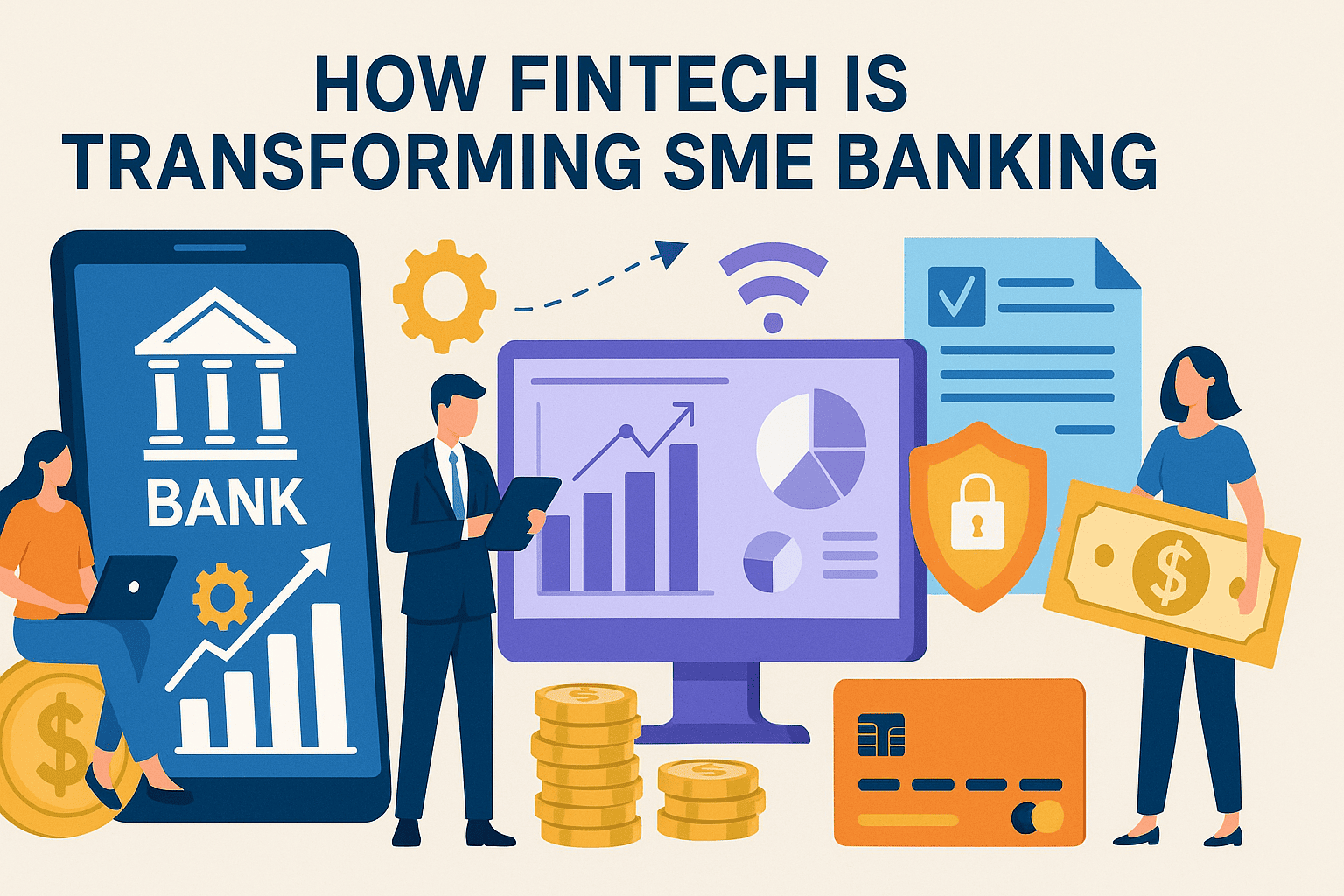
Introduction
Small and Medium Enterprises (SMEs) are the heartbeat of any thriving economy. They generate employment, drive innovation, and boost GDP. Yet, ironically, when it comes to banking and financial support, they’ve long been left behind. Traditional banks often treat SMEs as high-risk and low-priority customers, tangled in red tape and outdated processes.
Enter Financial Technology, or fintech—a game-changer that’s flipping the script. From mobile wallets to AI-powered loans, fintech is reinventing how SMEs access and manage financial services. So, what exactly is fintech doing for SME banking? Let’s break it down.
Understanding Financial Technology (Fintech)
What is Fintech?
Fintech is the blend of finance and technology. It refers to innovative tools and platforms that improve and automate the delivery of financial services.
Evolution of Fintech in Banking
Initially, fintech was all about digitizing traditional banking. But today, it’s creating entirely new models—think digital-only banks and AI lending bots.
Where Fintech and SME Banking Intersect
- Payments & transfers
- Lending & credit
- Bookkeeping & financial planning
- Customer onboarding & verification
Current Challenges Faced by SMEs in Banking
Limited Access to Credit
Many SMEs struggle to get loans due to lack of collateral, short operating histories, or low credit scores.
Complex Loan Processes
Traditional loan applications can take weeks, with mountains of paperwork and back-and-forths.
High Banking Costs
Maintenance fees, transaction charges, and other hidden costs can eat into SME profits.
Lack of Tailored Services
Banks often provide one-size-fits-all solutions that don’t cater to the diverse needs of small businesses.
How Fintech Is Solving These Problems
Fast Loan Approvals Using AI
Platforms like Kabbage use real-time data and AI to assess creditworthiness—no long waits, no thick files.
Peer-to-Peer Lending
SMEs can now borrow directly from individuals or investors, skipping the middleman.
Alternative Credit Scoring
Instead of just credit scores, fintech evaluates:
- Transaction history
- Social media data
- E-commerce sales
Smart Bookkeeping Tools
Software like QuickBooks and Zoho Books use automation to simplify invoicing, tax prep, and cash flow management.
Fintech Innovations Empowering SMEs
Digital-Only Banks
Neobanks offer 100% online banking with zero paperwork, 24/7 access, and user-friendly interfaces.
Mobile-First Solutions
Mobile apps now let SME owners:
- Track transactions
- Accept payments
- Apply for loans—all from their phone
Invoice Financing
Waiting for clients to pay invoices? Platforms like Fundbox and Invoicera offer upfront cash against unpaid invoices.
Blockchain for SMEs
Blockchain helps SMEs:
- Track shipments
- Confirm payments
- Build transparent transaction records
Case Studies of Fintech Success in SME Banking
Kabbage (USA)
Kabbage provides instant lines of credit based on real-time business data. Fast, flexible, and fully digital.
Tide (UK)
Tide offers a complete digital banking experience, built especially for small business owners.
RazorpayX (India)
This fintech unicorn helps Indian SMEs automate payroll, payments, and accounting—all in one platform.
Role of Artificial Intelligence and Machine Learning
AI in Fraud Detection
Smart algorithms scan for unusual activity to prevent fraud before it happens.
Personalized Financial Advice
AI bots analyze spending and offer custom insights—like a virtual CFO.
Predictive Analytics
ML tools forecast cash flows, enabling better planning and investment.
Regulatory and Compliance Considerations
Data Privacy Laws
Fintechs must comply with global standards like GDPR or India’s DPDP Bill.
KYC & AML Requirements
Fintechs automate Know Your Customer (KYC) checks and Anti-Money Laundering (AML) monitoring.
Licensing Needs
Depending on the region, fintech companies need regulatory approvals to operate legally.
Collaboration Between Traditional Banks and Fintechs
Embedded Finance
Banks are integrating fintech tools to offer better user experiences—like instant loan approval or smart expense tracking.
APIs and Open Banking
Banks expose APIs, allowing fintechs to build services on top of traditional infrastructure.
BaaS Platforms
Banking-as-a-Service providers help startups offer full-fledged banking features without building from scratch.
The Role of Big Data and Cloud Computing
Cloud-Based Banking
Helps SMEs access financial tools anytime, anywhere.
Real-Time Insights
SMEs can now view daily cash flow, overdue invoices, and financial projections on dashboards.
Scalability
Cloud services grow with your business—no need to invest in expensive hardware or software.
Fintech’s Impact on Financial Inclusion
Serving the Underserved
SMEs in rural or remote areas can now access credit, thanks to mobile-first fintech platforms.
Micro-Financing Models
Offer loans as small as $100, ideal for tiny businesses and self-employed individuals.
Gender Equity
Fintech platforms are helping bridge the financial gap for women-owned businesses.
Risks and Limitations of Fintech for SMEs
Cybersecurity Concerns
More digital access means higher risk of hacking, phishing, and data theft.
Tech Dependency
A system glitch or app downtime can paralyze financial operations.
Financial Illiteracy
Without proper training, SME owners may misuse or underutilize fintech tools.
Future Trends in Fintech for SME Banking
Open Banking
SMEs will control their data and choose who gets to see it, improving transparency and competition.
Embedded Payments
Payment solutions integrated directly into software platforms—no extra steps.
AI-Driven Lending
Lenders will make decisions in seconds using AI models trained on diverse data.
Tips for SMEs to Leverage Fintech Effectively
- Choose Trusted Platforms: Look for reviews, security certifications, and proven track records.
- Invest in Training: Empower your team to use fintech tools efficiently.
- Keep Learning: Technology evolves fast—keep up to stay ahead.
- Monitor Metrics: Use dashboards to track finances, spot risks, and forecast growth.
- Stay Compliant: Always follow data protection and local financial laws.
Conclusion
Fintech is not just a buzzword—it’s a lifeline for SMEs navigating the complex world of finance. Whether it’s securing a loan in minutes or managing invoices with a tap, the transformation is real and revolutionary. As tech continues to evolve, SMEs that embrace fintech will be the ones that thrive, grow, and lead the way.
FAQs
1. How does fintech help SMEs grow?
By simplifying access to credit, automating finances, and offering tailored solutions, fintech helps SMEs focus more on business and less on bureaucracy.
2. Are fintech services safe for small businesses?
Most reputable fintech platforms use encryption, multi-factor authentication, and regulatory compliance to ensure security.
3. Do SMEs still need traditional banks?
Yes, but increasingly in collaboration with fintechs. Many SMEs use both to get the best of both worlds.
4. What is the best fintech tool for SME accounting?
QuickBooks, Zoho Books, and Xero are top choices for their ease of use, integrations, and affordability.
5. Can fintech help startups with no credit history?
Absolutely. Alternative credit scoring methods make it possible to evaluate startups based on cash flow, transaction data, and more.






